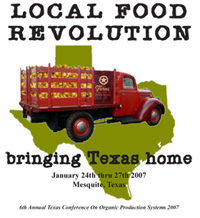 |
||
Ron’s ArticlesKeep It Real HomeyMarch 2007
Then it hit me. This conference exemplified the growing polarization in organics. On one side are proponents of the simple natural approach to every aspect of life from farming to personal lifestyles. The others are the purveyors of new fangled pseudo scientific and usually more costly “breakthroughs.” I met a guy who spent $25, 000 on a compost extractor. When I converted to organics over a decade ago, there were no conferences - 1 stop info centers. I gathered information one-to-one. I met with people like Malcolm Beck, the father of organics in Texas. I told anyone who’d listen what I was doing and then asked “Is there anything I should do differently?” At the conference I was surrounded by PhDs, scientists, business people with new products, ranchers, farmers and landscape professionals - all focused on organics, but with widely ranging visions. I went on the Farm Tours - visited several organic farms where families were sustaining themselves happier and healthier with better more nutritious animals. I didn’t see anything bio-engineered or bio-dynamic, cryonic bionic or super organic gizmos on any of these farms. I was very impressed with Rehoboth Ranch near Greenville. Robert and Nancy Hutchins are raising their 11 younger children - and their oldest son and his wife are raising their daughter, on land free of pesticides, artificial fertilizers and synthetic hormones. They sell beef, lamb, free range chickens and turkeys and raw goat milk among other products. They work together to provide nutritious food for themselves and food of such quality that people drive 100 miles to buy it at a premium. A gallon of raw organic goat milk is $15, and there are 80 people on the waiting list. It’s clear that the Hutchins’ simple natural methods work. But when I went to the conference sessions to be educated by the “experts,” many of them espoused ideas incompatible with what works so well for the Hutchins. Fortunately, I enjoyed some inspiring presentations. Donald Jansen’s formal education is in theology, education, and communications. He taught Communications at Ohio University for 13 years. But, for the past 20 years he’s been advancing the research of his mentor, Dr. Maynard Murray, a pioneer in sea energy agriculture. He uses sea solids as the sole nutrients at his hydroponics farm at North Fort Myers on Florida’s west coast. They sustain plants on nothing more than ocean nutrition. Think of it. The ocean contains all the minerals on the elemental chart. The only hitch is that he must go 25 miles out to find water that is clean enough to use. William Cureton, AKA Captain Compost, put on a great program. With all the fancy smancy compost machines on the market, he showed that the simple approach is still best. He sets up a 3 sided bin using wooden shipping pallets and piles up green and brown organic materials. His only other tools are a spade fork and buckets. His secret ingredient is his own urine. Urine? Nasty! But, think about it. Urine is a sterile waste product full of ammonia that microbes seek to break down. Why buy something to stimulate your compost pile when nature gives us the answer free of charge? It’s simple and natural. At the exhibits, I found a company with a new fertilizer generated from different strands of ?? (If I can’t pronounce it, why spell it?) in stainless steel bio-reactors. Whatever this stuff is, it may not be symbiotic with our native soils. In the fertile forest, I’ve never seen stainless steel cylinders. This conference energized me, but it also confused me. I’ve studied nature for 10 years. Simply using compost, some minerals and live compost tea, I can transform any landscape. My success rate is outstanding. A good balanced approach always works well. Keep it real homey. Don’t buy into the hype. Seek out the best source of compost. It doesn’t matter how beneficial microorganisms are or how many millions of spores there are if there’s no life in the soil. You must improve the organic matter and mineral content in the soil before it can sustain life. Keep it real homey. The best compost is that made on your own property with your own yard and kitchen waste. The next best option is to find a nearby supplier with the best record of transforming depleted soil. This won’t be someone who ships in compost from thousands of miles away by the tractor trailer load. The microbes in your area crave organic matter indigenous to your area. Keep it real homey. To save the world one yard at a time, start in your own backyard. Start recycling the waste from your own property into your own yard growing life-giving produce you can consume recycling the waste to make your compost even better. Ron Hall, Lawn Doctor Ron, is a certified landscape professional, a certified master nursery professional, a licensed irrigator, a licensed pesticide applicator and certified arborist. In addition to being a full-time Dallas firefighter, Ron has over twenty-five years experience in landscaping with a concentration on organic gardening. He and his wife Mona own Ron’s Organics, Inc. in Mesquite www.organicdynamics.com. 
|
|
|

 “A healthy garden and a happy man,
“A healthy garden and a happy man,the two go hand in hand, only with more God and less man.” — Ron Hall  |
||
